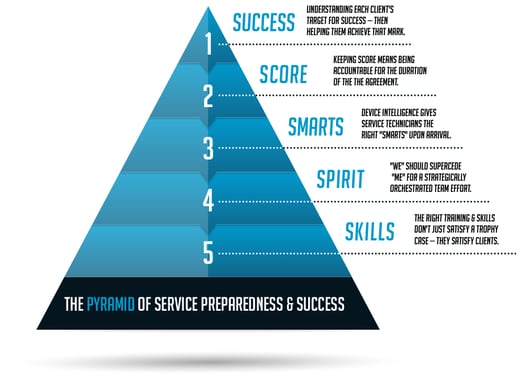
"My current vendor doesn't understand that just showing up on time isn't enough." - Davin G., IT Director
Legendary NCAA Basketball coach John Wooden once said “Failing to prepare is preparing to fail.”
Known as the “practice coach,” Wooden was notorious for focusing on intricate details of “the process” —not just the game itself. His teams practiced everything: Putting their socks on correctly to avoid blisters, how to carry oneself before and after a game.
In sports – and in the management of your corporate print fleet – it’s not just about who has the will to win, or even who shows up first. It’s about who comes prepared. Impressive statistics regarding a technology partner’s average response time may look great in the box score, but they rarely account for the actual results (AKA resolution).
Wooden spent years identifying and studying specific behaviors and characteristics that defined a successful individual. In 1948, he unveiled his "Pyramid of Success," which not only helped him build his basketball legacy, but offered us all a diagram for both individual and team excellence.
With a similar degree of excellence in mind, our "Pyramid of Service Preparedness & Success" helps your organization assess the capabilities of your corporate print fleet service provider. Do they come prepared?
After all... When servicing your fleet, just showing up on time isn’t enough.
5 Ways to Know Your Service Team Comes Prepared:
#5 — They're Trained With the Right Skills.
Advanced-level training and certification doesn’t just satisfy the company trophy case. It satisfies clients.
The reality is that many print-related services issues today are complex in nature. The variables that exist often require much more troubleshooting than what can be found in a standard training manual.
Manufacturer distinctions such as Canon’s Association of Technical Service Professionals (ATSP) certification require literally hundreds of hours of onsite and online training for technicians. The job function-based exams are designed to measure both the knowledge and the demonstration of the skills that are required in real-world settings for a support professional against a set of standards for competency and performance.
#4 — They Showcase Team Spirit.
"Teamwork is not a preference. It's a requirement." - John Wooden
Inside Wooden’s Pyramid of Success lies the “Team Spirit” block, which he clarifies as “a genuine consideration for others, an eagerness to sacrifice personal interests of glory for the welfare of all.”
“The star of the team is the team. ‘We’ supercedes ‘me,’” he continues.
This concept is crucial when managing your corporate print fleet. Ask yourself: Does your service team care? Do you trust them? Can they help you? If they've developed their own true sense of team, your answer to those questions is far more likely to be a resounding "yes!"
From the front-line technicians, phone support team, internal staff who trains them, to the account representative responsible for staying on top of current needs: The degree to which these parties synchronize is key to service fluidity.
Are services just haphazardly implemented? Or are they strategically orchestrated?
#3 — They Arrive With Proactive Smarts.
Device intelligence plays a big part in the "smarts" a technician owns by the time he or she arrives to your office lobby. It's a key first step in proactive service.
How much data can your technician collect on your equipment when an issue arises, and how quickly? Utilizing key machine-embedded tools (like Canon ImageWare Remote), a technician receives automated service alerts for errors, jams, and other similar issues, and he or she can also pull up extensive equipment service data on a given machine from their mobile devices - before they arrive on site.
Three scenarios where such resources have a big impact:
- Proactive Response: Upon receiving an alert, a technician might pull up the error code from their machine and see it’s a communication code. They can contact the client by phone, and have them simply cycle the machine down to clear the code without needing to dispatch.
- First Call Completion: When a technician sees an error code, they can view technical documents about suggested fixes and suggested parts attached to that code (prior to dispatch). By the time he or she is in route, they are already trouble shooting on repair with the wealth of information gained (as well as the right parts!). So they are more informed, and they’re better prepared.
- Preventative Care: With available diagnostic tools, technicians may also view trends with a specific machine. As an example, if a client is running a special type of paper on a machine on a regular basis, feed rollers that have a standard lifespan of 200,000 copies may be lasting only 70,000. A technician would know this from the trend report, and would know to anticipate such ahead of time.
#2 — They're Prepared to Keep Score.
Keeping score helps any team stay on track. As any basketball fan knows, games are often won - or lost - at the final buzzer. Whether your agreement is for 36 or 60 months, it is a full 60-minute commitment.
Metrics are a coveted tool for keeping score and showing results. Is the technology provider measuring things like “Response + Resolution Time” and “First Call Completion Rate?” A reputable partner should not only store, collect and continually work to improve upon such data, but should also be transparent in sharing it with anyone who asks.
Fast response is great, but anyone can show up in two hours. Do those technicians have device insights and expertise upon arrival to deliver resolution? Furthermore, device statistics and performance trends supplied by Canon’s ImageWare Remote are powerful tools only if they are being regularly studied by the people generating them.
It’s no secret that corporate offices expect a proactive response to service needs to avoid costly downtime. In fact, a double-blind survey conducted by Smart Advantage, Inc. asked Copier Dealers Association (CDA) customers and prospects what they valued most in an office equipment provider. Those surveyed were asked to rank a list of 28 wide-ranging attributes.
The top three customer/prospect wants, according to the data?
- They want their issues resolved quickly.
- They want high speed response to their support/service requests.
- They want their equipment repaired on the first visit.
Any service strategy should specifically address a proactive, preventative nature to its service response. Don’t just get there fast. Come prepared.
#1 — They're Pledged to Client Success.
When the final buzzer sounds on your agreement term, did you end up with a win?
Service providers must acknowledge that every client has a different target for success. Understanding what that specific target is, and working holistically to help you achieve that mark should be driving force for any technology provider.
- They Back up Service Commitments: From billing accuracy to response plus resolution time, service capabilities should not just be talking points at practice, but should show up on the hardwood during the game.
- They Improve Total Cost of Ownership: Does your provider line out ALL the factors that affect your Total Cost of Ownership? This means that strategies for understanding - and improving - your total costs isn't just a discussion at tip-off. It needs to happen the entire 60 minutes of play.
- They Maximize Your Return on Technology Investment: In the end, it comes down to results. Are you operating more efficiently than before? Is there measurable business value attached to all the hardware and solutions? Does your provider remain accountable for solution recommendations and superior service and support responsiveness - maintaining unwavering conviction to each and every commitment?
Seeking a level of proactive, preventative service for your corporate print fleet? Does your technology vendor come prepared? To learn more about the elements of a true technology partnership, schedule a visit with a Datamax Key Account Program Consultant!
Steve Kennemer is the Director of Service Datamax Texas. He can be reached at (800) 633-1526.



